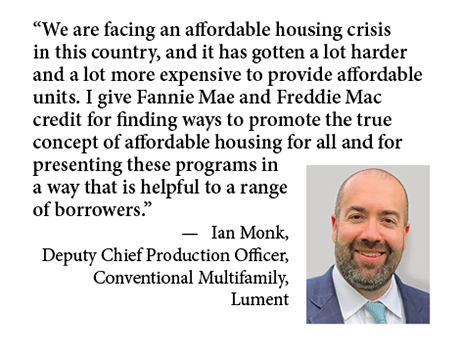A trio of social-impact lending programs is enticing enough to convince market-rate multifamily owners and investors to dip their toes into the affordable housing sector. These recently launched initiatives all promote the creation and preservation of workforce housing.
Unlike low-income housing tax credits, Section 8 rent vouchers and other longstanding programs centered on helping families with low and very-low incomes to afford housing, the newest offerings primarily aim to assist missing middle renters — or those with modest-to-low incomes. That’s according to Ian Monk, deputy chief production officer for conventional multifamily at Lument — which is educating its borrowers about the competitive pricing, generous proceeds and potential for lengthy amortization periods available from Fannie Mae and Freddie Mac.
“By charter, the government-sponsored enterprises (GSEs) have a duty to help provide housing that is affordable to all people, including families with only moderately low incomes,” Monk says. “In the multifamily arena, they may serve those families in fully dedicated affordable communities, but they can also serve them in conventional, market-rate properties that adopt some affordability initiatives using one of these social-impact loan structures.”
The GSEs are making a strong push in 2024 to expand participation in the three social-impact loan products, making this an excellent time for anyone seeking multifamily financing to explore each option and identify the best fit for their needs. Borrowers stand to benefit from attractive terms on agency loans while establishing symbiotic relationships that help communities and the GSEs increase or preserve affordable options for renters, Monk says.
Here is a rundown of each program’s significant features:
Workforce Housing Preservation is a Freddie Mac program that enables borrowers to voluntarily set rent restrictions on at least 20 percent of a property’s units to support tenants with moderate to low incomes. Available in all fixed-rate structures of seven years or longer, the program offers competitive pricing, and for borrowers with low leverage, Freddie Mac will consider 35-year amortization, Monk says.
“Who doesn’t want the potential for reduced pricing on their market interest rate right now, or wouldn’t want the possibility of 35-year amortization?” Monk observes. “At the same time, those borrowers can help push Fannie Mae and Freddie Mac’s housing goals and provide cost-effective, affordable housing for low-income families and individuals.”
Sponsor-Dedicated Workforce is a similar product offered under Fannie Mae. Like Freddie Mac’s workforce housing program, it is for conventional market-rate multifamily properties and requires setting aside 20 percent of the units at rents affordable to residents earning 80 percent of area median income (AMI). Both programs set rent controls in the loan documents, with straightforward rent monitoring that the borrower certifies annually. Sponsor-dedicated workforce rent controls are binding for the life of the loan.
Individual loan terms depend on deal specifics, but applicants can expect competitive pricing with opportunities for creative amortization, Monk says. The program gives borrowers 12 months to comply with rent affordability.
“Both of these programs drive workforce housing affordability, meaning they are for otherwise conventional, market-rate properties that are not encumbered by existing regulatory agreements,” Monk says. “Some borrowers are surprised to learn the annual review or certification process isn’t governed by a housing finance agency and that they simply self-certify compliance each year. And unlike standard affordable housing programs that generally restrict both a property’s rent and income, Freddie Mac’s rent preservation program and Fannie Mae’s sponsor-dedicated structure restrict only rent.”
Sponsor-Initiated Affordability is a separate Fannie Mae program that is more likely to appeal to dedicated affordable housing operators who are prepared for more involved oversight in exchange for low borrowing costs. The chief advantage over the previously discussed workforce programs is a low debt service coverage requirement, as low as 1.20 times net income, compared to the 1.25 that is more common under the workforce programs.
Unlike the other two Freddie Mac and Fannie Mae products, a sponsor-initiated affordability loan sets income affordability as well as rent levels for the life of the loan and requires third-party annual certification and an affordability agreement. Borrowers favoring this product tend to be motivated to make a social impact on housing affordability in their communities, Monk says, and will often leverage the affordability agreement and third-party certification to qualify for additional benefits, such as local tax abatements.
Sponsor-initiated affordability borrowers must create or preserve 20 percent of the property’s units to remain affordable for renters earning 80 percent of AMI, but applicants willing to make a greater impact on affordability may qualify for more favorable loan terms.
“If the borrower elects to increase the concentration of restricted units or makes them affordable to tenants earning a lower percentage of AMI, that can help to improve the pricing or credit metrics on the loan,” he says.
Preserving, Expanding Workforce Housing
These three social-impact lending programs are making a difference by preserving and expanding workforce housing options in communities throughout the nation, thanks to a concerted effort by the GSEs, lenders like Lument and borrowers willing to ensure a portion of their units remain affordable.
“We are facing an affordable housing crisis in this country, and it has gotten a lot harder and a lot more expensive to provide affordable units,” Monk says. “I give Fannie Mae and Freddie Mac credit for finding ways to promote the true concept of affordable housing for all and for presenting these programs in a way that is helpful to a range of borrowers.”
— By Matt Hudgins. Lument is a content partner of REBusinessOnline.
For more articles from and news about Lument, click here.


